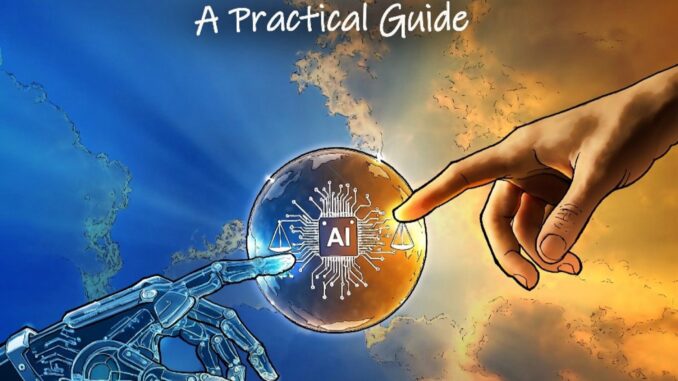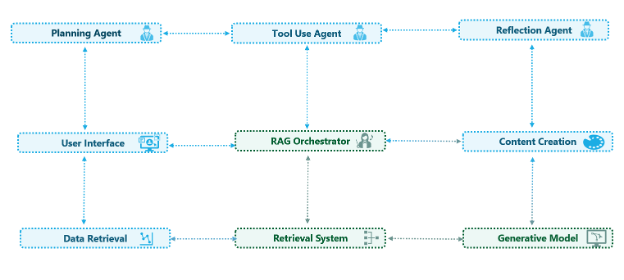
By Walson Lee
(Editor’s Note: What follows is an excerpt from “Mastering AI Ethics and Safety.” The book can be purchased here.)
Introduction
The rapid advancement of Artificial Intelligence presents both unprecedented opportunities and critical challenges for enterprise architecture and governance. As transformative technologies like Generative AI (GenAI) and Multi-Agent Systems (Agentic AI) reshape industries, the need for robust ethical and safety frameworks has never been more pressing. This eBook, “Mastering AI Ethics and Safety – A Practical Guide” available on Amazon, offers enterprise leaders and AI practitioners a practical roadmap and actionable strategies to architect, deploy, and govern AI responsibly within real-world business environments.
The cover design of the eBook highlights the intricate balance between AI governance and AI innovation. This duality is symbolized by the interplay between a human hand (representing ethical oversight) and a robot’s hand (representing technological advancement). At the center, a circular AI motif emphasizes key AI Ethics considerations and guiding principles, serving as a focal point for the core values underpinning responsible AI development. The result is a cover design that not only visually represents the book’s core message but also reflects the collaborative potential between human insight and AI technology.
This eBook provides actionable insights to enable readers to:
- Establish a Strong Ethical Foundation
- Embed Ethics Across the AI Lifecycle
- Navigate Complex AI Challenges (such as Generative AI and Agentic AI)
- Implement Practical Tools & Techniques – including ethical AI architecture & design patterns
- Ensure Regulatory Readiness
- Foster an Ethical AI Culture
- Continuously Monitor and Adapt
Since Multi-Agent Systems (MAS, also known as Agentic AI) is the current hot topic of AI development, the remaining of this article will excerpt key sections of the Chapter 9 “Multi-Agent Systems and Ethical Considerations”.
Excerpt of “What Are Multi-Agent Systems (MAS)?” Section
A multi-agent system consists of several autonomous agents that interact through communication and are connected by various relationships. Those agents can act in an environment and have different “spheres of influence” (which may coincide). Figure 1 illustrates the core concept of a multi-agent system.
A multi-agent system can exhibit the following characteristics:
- Each agent has limited capabilities and information on the overall problems’ resolution.
- Each one has a partial point view.
- There is no global control.
- All data and domain knowledge are decentralized.
- Computation is asynchronous.

Figure 1 – Multi-Agent System Conceptual Diagram
Excerpt of “What Makes MAS Special?” Section
What sets MAS apart from other AI systems is their inherent ability to manage distributed and dynamic environments. Each agent in a MAS possesses unique characteristics, such as autonomy, social ability, reactivity, and proactivity. Autonomy allows agents to operate without direct human intervention, making decisions based on their perceptions and objectives. Social ability enables agents to interact and collaborate with other agents, sharing information and resources to achieve common goals. Reactivity allows agents to perceive and respond to changes in their environment, while proactivity enables them to take initiative and pursue long-term objectives. These characteristics make MAS particularly well-suited for applications that require adaptability, scalability, and robustness.
Unlike traditional AI systems, which typically involve a single, centralized agent, a MAS can leverage the collective intelligence and collaboration of multiple agents. This distributed approach offers several advantages:
- Scalability: MAS can manage large-scale problems by distributing tasks among multiple agents.
- Optimization: MAS can be optimized through various techniques, such as prompt optimization and topology design.
- Flexibility: Each agent can be designed to specialize in specific tasks, making the system adaptable to different challenges.
- Robustness: The failure of a single agent does not necessarily compromise the entire system, enhancing overall reliability.
Excerpt of “The Ethical Dimension of Multi-Agent Systems” Section
While the benefits of MAS are clear, their deployment also raises important ethical considerations. Issues such as coordination, accountability, and bias must be addressed to ensure that multi-agent systems operate fairly and responsibly. Establishing clear guidelines for ethical behavior and robust communication frameworks are essential steps in mitigating these challenges.
By understanding the fundamental principles of MAS and their role in enterprise AI solutions, we can better appreciate both their potential and the ethical considerations they entail. The following sections will delve deeper into the recommended reference architecture and key ethical challenges, providing a comprehensive overview of this exciting and evolving field.
Coordination
Coordination in MAS involves ensuring that multiple agents work together harmoniously to achieve common goals. This requires effective communication, synchronization, and conflict resolution mechanisms. Poor coordination can lead to inefficiencies, resource wastage, and even system failures.
Real-World Scenario: In healthcare, MAS can be used to coordinate patient care among multiple providers. If the agents fail to communicate effectively, it could result in conflicting treatment plans, delayed care, or even medical errors.
References:
- Multi-Agent Systems: Technical & Ethical Challenges of Functioning in a Mixed Group (https://direct.mit.edu/daed/article/151/2/114/110611/Multi-Agent-Systems-Technical-amp-Ethical)
- New Report: Multi-Agent Risks from Advanced AI (https://www.cooperativeai.com/post/new-report-multi-agent-risks-from-advanced-ai)
Accountability
Accountability in MAS refers to the ability to trace actions and decisions back to the responsible agents. This is crucial for identifying and addressing errors, ensuring compliance with regulations, and maintaining trust in the system.
Real-World Scenario: In financial trading, MAS can be used to execute trades autonomously. If a trade goes wrong, it is essential to determine which agent made the decision and why. Lack of accountability can lead to significant financial losses and legal issues.
References:
- Multi-Agent Systems: Technical & Ethical Challenges of Functioning in a Mixed Group (https://direct.mit.edu/daed/article/151/2/114/110611/Multi-Agent-Systems-Technical-amp-Ethical)
Bias Prevention
Bias prevention in MAS involves ensuring that the agents’ decisions are fair and unbiased. This requires careful design, testing, and monitoring to avoid discrimination based on race, gender, or other factors.
Real-World Scenario: In hiring processes, MAS can be used to screen job applicants. If the system is biased, it could unfairly favor or disadvantage certain candidates, leading to discriminatory hiring practices.
References:
- New Foundations of Ethical Multiagent Systems (https://www.ifaamas.org/Proceedings/aamas2020/pdfs/p1706.pdf)
- Can We Trust AI Agents? An Experimental Study Towards Trustworthy LLM (https://arxiv.org/html/2411.08881v1)
Excerpt of “Recommended Reference Multi-Agent Architecture for AI Ethics” Section
To implement various architectural and design patterns and models for addressing AI Ethics Guiding Principles is quite complicated given that some topics are still in the active research stage. Hence, we need modular and flexible architecture to meet the current AI ethical requirements and anticipate future AI technology advancements, particularly future GenAI and Artificial General Intelligence (AGI) models. A recommended architecture that effectively meets these needs is one based on Multi-Agent Systems (MAS) and Retrieval-Augmented Generation (RAG) patterns. This combination allows for the integration of AI ethics considerations within a collaborative and adaptable framework.
RAG Pattern in Conjunction with AI Agentic Design Patterns
The following simplified conceptual architecture diagrams illustrate how the RAG pattern can be integrated with AI Agentic Design Patterns to create robust and collaborative AI systems:

Figure 2 – RAG with Multi-Agent Collaboration
Figure 2 illustrates the integration of the Retrieval-Augmented Generation (RAG) pattern with multi-agent collaboration, showcasing how various agents coordinate, use tools, reflect, and create content, all managed by a central RAG orchestrator.
RAG with Multi-Agent Collaboration
- Planning Agent: Coordinates the overall process.
- Tool Use Agent: Interacts with external tools to perform specific tasks.
- Reflection Agent: Reviews and improves the output.
- User Interface: Allows users to interact with the system.
- Data Retrieval: Fetches relevant information.
- Content Creation: Generates the final output.
- RAG Orchestrator: Manages the flow of data and interactions between components.
- Retrieval System: Retrieves relevant information from a knowledge base.
- Generative Model: Generates responses based on retrieved information.

Figure 3 – RAG with Reflection and Tool Use
Figure 3 illustrates the integration of the RAG pattern with reflection and tool use, highlighting how various agents interact with tools, reflect on their actions, and generate content, all managed by a central RAG orchestrator.
RAG with Reflection and Tool Use
- User Interface: Allows users to interact with the system.
- RAG Orchestrator: Manages the flow of data and interactions between components.
- Generative Model: Generates responses based on retrieved information.
- Reflection Agent: Reviews and improves the output.
- Tool Use Agent: Interacts with external tools to perform specific tasks.
- Retrieval System: Retrieves relevant information from a knowledge base.
- Data Retrieval: Fetches relevant information.
- Content Creation: Generates the final output.
- Knowledge Base: Stores the information used for retrieval. For addressing AI Ethics guiding principles, this knowledge base should contain a set of knowledge or facts, such as legal or regulatory requirements, enterprise AI ethics policies and guidelines, specific domain (e.g., healthcare industry) know-how or business rules, security, and safety rules, etc.
These conceptual architectural diagrams illustrate how the RAG pattern can be integrated with AI Agentic Design Patterns to create robust and collaborative AI systems. For more detailed information, you can explore the DeepLearning.AI course on AI Agentic Design Patterns with AutoGen (https://learn.deeplearning.ai/courses/ai-agentic-design-patterns-with-autogen/lesson/1/introduction) and the Azure AI Search documentation on RAG (https://learn.microsoft.com/en-us/azure/search/retrieval-augmented-generation-overview).
Conclusions
Chapter 9 of the eBook concludes by underscoring the critical importance of embedding ethical considerations throughout the lifecycle of MAS development and deployment. It stresses the ongoing need for rigorous research and close collaboration among AI practitioners, ethicists, and policymakers to navgate the evolving ethical landscape of MAS. By cultivating a strong ethical AI culture and proactively monitoring and adapting to new advancements, we can effectively leverage the transformative potential of MAS while safeguarding the well-being of individuals and society.
This excerpt from “Mastering AI Ethics and Safety” illustrates the practical and comprehensive guidance the eBook offers across the entire spectrum of AI ethics and safety challenges, including the critical considerations for emerging technologies like MAS. Readers eager to gain a comprehensive understanding of AI ethics and safety, including in-depth insights into MAS, can find the full eBook available on Amazon.
Acknowledgements
As the author of this eBook, I would like to express my sincere gratitude to the many individuals who helped shape my ideas and provided invaluable support. My heartfelt thanks to Jim Wilt, David Craford, Andrew Wolff, and Kevin Brown for their significant contributions. I would also like to acknowledge Andrew and Kevin, who are with the Holistyx Group (https://theholistyxgroup.com/) and are planning to integrate key content from the eBook into their workshop offerings.
